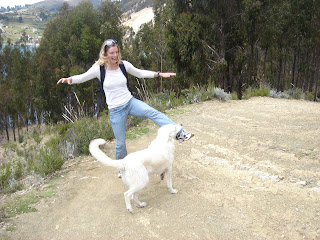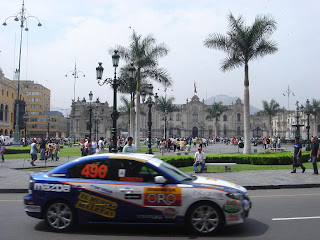Hi Guys,
I am writing from Puno, Peru where internet is cheap and traveling easy. We are definitely on the "Gringo Trail" now. To get anywhere you just have to follow the whities with fanny packs and giant backpacks.
So, after Potosí, Mike and I headed to La Paz. La Paz is a bustling big city (we felt remarkably safe however) filled with people going about their business and open air markets everywhere you look. In the shadow of Illimani mountain, La Paz fills a valley, and homes crawl up each of the walls. The most interesting market we saw was the "witches market" where amongst others things, they sell llama fetuses at almost every stall, ranging in scope from keychain sized (with unformed shrimp like tails) to about a foot long. Our guide book said not to take pictures there unfortunately but it was quite a site to see.
We also went to extremely biased, anti-American Coca Museum dedicated to the revered coca leaf. As unbalanced as it was (I guess it is to be expected when it is a museum dealing with a plant that when in drug form is a scourge on (American/western) society) it was very interesting. Did you know for example, that coca paste, the first stage in making cocaine, is made by stomping on the leaves, just like with grapes being made into wine? The coca leaf is also apparently quite nutritious and used, even now, in Coca Cola's secret recipe.
La Paz was a day to relax for us however, so we went and saw the movie 300 (brand new here but I bet it has been out in Canada for quite some time), which Mike has since become obsessed with. I think he knows everything these is to know about it now, from details about the battle of Thermopoli to the actors work out regime. Anyway, as much as we enjoyed our day in La Paz, we raced on to Copacabana...we really have to move now, we only have 2 weeks before we come home!

The hillsides of La Paz
Copacabana is nothing like it's namesake in Brasil. It is a small city on the shore of Lake Titicaca. It is touristy, but has a nice vibe. I was particulary impressed by the kindness of one local woman I was talking to who insisted on running to her apartment and making Mike apio tea (parsley I think) when she could see that he wasn't feeling well.

Overlooking Copacabana from a pilgrim's lookout on the top of a cerro
We took a boat from Copacabana to Isla del Sol, Island of the Sun, a long hour and half away from the city. Most tourists do a quick jaunt out to the island, leaving them not even enough time to even climb the many stairs (no small feat in this altitude...it took us almost an hour) into the town of Yumani proper on the Southern tip of the island. Luckily, we decided to stay the night. Actually, we stayed in the cheapest place we have stayed in yet, 15 Bolivianos each, just less than $2US, although we probably should have spent a little more for the luxury of a real flushing toilet. The first day we hiked to Pilco Kaina, ruins of an Inca temple. Unfortunately, this part of the island has been inundated by tourists and little kids run around commanding you to buy their wares, take their picture for payment or give them candy. It is quite sad actually, although we found that the children become quite friendly and like to teach you words in Aymara once you insist that you will not pay them for their picture and do not have candy.
Yumani was a neat place though, despite all the tourists. The whole town is built on a steep slope with stairs which made walking back to the hotel in the dark (no street lights) a little precarious, especially considering the amount of llama and donkey poop all over that we had seen but could only smell in the darkness.

Inca temple of Pilco Kaina on the island
The next day we headed out for the northern part of the island, a three hour hike along a sometimes non-existent trail--we ended up in the middle of farmers fields and having to jump a fence to get out of someone's back yard at one point. It was an absolutely beautiful hike and we didn't see another tourist the whole way. Locals were completely different than in the south as well. Everyone we encountered gave us a hearty, friendly hello as they passed, often with a caravan of donkeys or a small herd of cows. The best part of the trek though, was the puppy who followed us the whole journey. Young, still a little clutzy and afraid of the livestock we passed, "Gringo" as we named him was the cutest, sweetest little guy.

Gringo leading the way past a maize field and a traditionally dressed woman
 Still a puppy!
Still a puppy!
When we made it to the North of the island, we found out there was only one boat leaving for the south that day and we didn't have enough time to see the ruins, the reason we had made the trek. The ruins we didn't get to see are where the Inca's claimed the sun was born. It is too bad but Mike pacified me with the promise of many more ruins to come in Peru. It broke my heart to leave our new found travel companion so I asked if we could take Gringo back to Yumani where I assume his home is. Although the boatman was willing, poor Gringo was too scared of the spaces between the boards on the pier and wouldn't even be bribed by food. However, when the boat finally left, he forgot his fear, and ran out on the pier after us. Poor guy wanted to come. We can only hope that he follows some other tourists back the other direction or makes it back on his own.
From Copacabana we headed to Puno where we have been taking it easy so that Mike recovers from whatever bug he's got. We relaxed all this morning and then went to the floating reed islands, made out Tortora reeds that grow in abundance here. Although extremely comercialized now, the 40 or so man-made floating islands were quite a peculiarity. Each island of up to about 10 families has its own president and the ancestors of the Aymara speaking people who live there now built the islands to flee the conquering Incas. It also worked out rather conveniently when the Spaniards arrived since they managed to avoid working in the mines of Potosí. Now however, they seem to make a living pushing souvenirs on tourists. The islands are anchored but can be moved, joined and separated as need be. They are soft and springy to walk on and apparently have to be constantly maintained as the reeds on the bottom rot away.

Boat made out of Tortora reeds

A view of a few of the islands


The local version of coke. The colour is a little off-putting (any one take multi-vitamins?), but tastes like the fizzy valentines hearts. Not bad actually.













 Juanita
Juanita From inside the convent.
From inside the convent.


 The figure refered to as the "astronaut" (extra terrestrial theories about the lines abound by the way)
The figure refered to as the "astronaut" (extra terrestrial theories about the lines abound by the way) The monkey...can you see it? It is very faint. Strange, since monkeys aren't found anywhere near here. The Nazcans must have had contact with jungle peoples.
The monkey...can you see it? It is very faint. Strange, since monkeys aren't found anywhere near here. The Nazcans must have had contact with jungle peoples. The hummingbird.
The hummingbird.



















 Machu Picchu is going to have to have it's own entry. Coming up.
Machu Picchu is going to have to have it's own entry. Coming up.
 Overlooking Copacabana from a pilgrim's lookout on the top of a cerro
Overlooking Copacabana from a pilgrim's lookout on the top of a cerro 

 Still a puppy!
Still a puppy!




